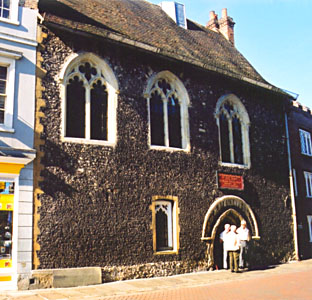
Eastbridge Hospital, Canterbury
Photo © S. Alsford
Very soon after Becket's murder in 1170, the cathedral where he was killed
and buried became a focus for pilgrimage. As part of an effort to provide
accommodation for pilgrims, the Hospital of Thomas the Martyr was founded.
A penitent Henry II is said to have given Becket's sister a toll bridge
over the eastern branch of the Stour, and it was adjacent that the
hospital was founded, being built directly over the river; it became known
as the Eastbridge Hospital. The sister's son became the first warden
of the hospital, which is one of Canterbury's oldest surviving structures.
The date of foundation of the hospital is uncertain, some thinking it may
have been in existence by 1176, although a more conservative estimate would
be 1190. The founder was Canterbury merchant Edward Fitz Odbold. This was
a period when the urban economy was flourishing, the urban community
was developing aspirations for self-government, and its mercantile leaders
were displaying civic responsibility through hospital foundations. Maynier
le Riche had, during Henry II's reign, already established one to support
seven poor people of the town. A generation after FitzOdbold, Alexander
de Gloucester set up a hospital for poor priests, and William Cockyn founded
a hospital dedicated to SS. Nicholas and Katherine, adjacent to the
Eastbridge Hospital; the two were subsequently merged.
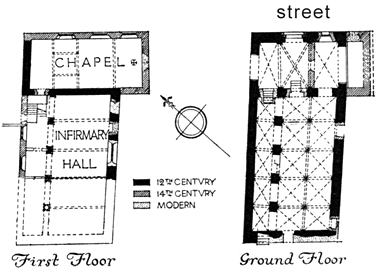
Eastbridge Hospital, floorplan
Adapted from Walter Godfrey, The English Almshouse,
London, 1955.
The hospital was entered from the street via the doorway seen in the
photo at top; the present street level is higher today, so that one
descends into the vestibule, whereas originally there were steps up to it.
Only two of the three bays visible in the photo were part of the original
hospital.
The hospital acquired some wealthy endowments, but had fallen into disuse
by 1342, when refounded by the Archbishop and amalgamated with the
Hospital of St. Nicholas and St. Katherine. It reached its peak in the
1380s. It later fell into disrepair again and after the Dissolution was
converted to a school and almshouse. It retains its function as an
almshouse today, while its chapel continues to be made available to
groups making a pilgrimage to Canterbury.
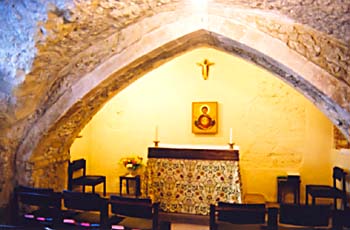
Eastbridge Hospital, chantry chapel
Photo © S. Alsford
Immediately to the left of the vestibule is a small chapel, with a fourteenth-century archway leading into the sanctuary.
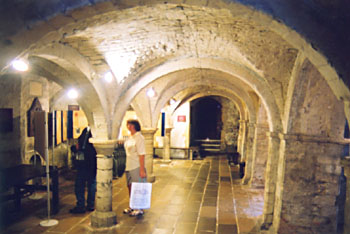
Eastbridge Hospital, undercroft
Photo © S. Alsford
Stairs from the vestibule lead down into the late twelfth-century undercroft, where there were a dozen or so beds of straw for pilgrims, probably in the cubicles formed by the dividing walls (right-hand side of the photo above); new straw was piled atop old, with no concern for hygiene. At the time of its refounding, just before the Black Death, the hospital's mandate was to serve the infirm poor, pregnant women, and poor pilgrims – healthy pilgrims were allowed a bed, if there were room, for a few pence. Attending to the needs of inmates was assigned to a woman of good character and advanced age (over 40), to ensure that the male pilgrims would not be tempted to make advances. On the floor above this dormitory were the refectory and infirmary.
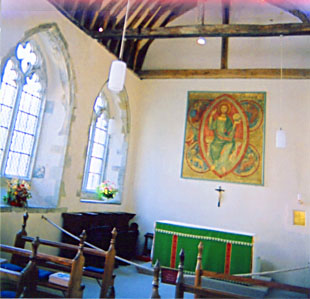
Eastbridge Hospital, main chapel
Photo © S. Alsford
The main chapel was above the vestibule; part was contemporary with the refectory and undercroft, but the final shape was given in the fourteenth century. The thirteenth-century roofbeams at one time supported a small spire. The painting above the altar is a modern reconstruction of a thirteenth-century mural depicting Christ in majesty, the original of which was uncovered in the refectory.